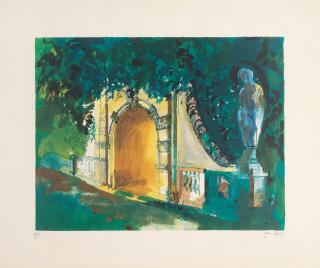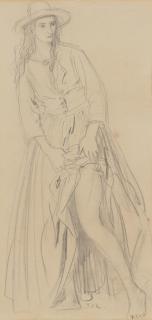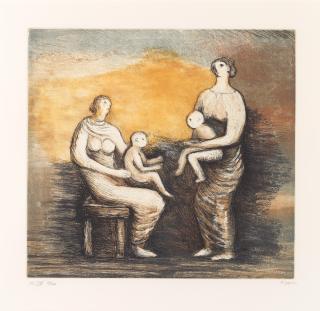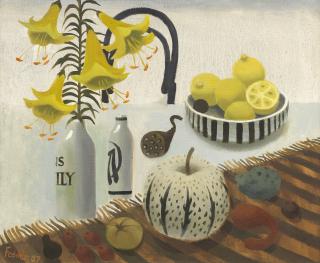Keith Vaughan 1912 - 1977
The artist Keith Vaughan
- British painter who began as a neo-romanticist but soon developed his own style.
- Met contemporaries during World War II, with whom he briefly joined forces.
- Also became known posthumously for his diaries, the »Keith Vaughan: Journals 1939-1977.«
John Keith Vaughan was a British painter born in 1912 at Selsey Bill, a point in the English Channel on the south coast of England. He worked for an advertising agency until the Second World War. The war was also a major break for Vaughan and had a great influence on his artistic and emotional development.
Although Vaughan was self-taught, he was able to exhibit his work for the first time during the war. He was drafted into the Non-Combatant Corps as a conscientious objector, and thus had to serve as a soldier anyway. While stationed at Ashton Gifford, a rural area around Codford in southern England, he painted one of his most famous works, The Wall at Ashton Gifford (1944). It is now in the Manchester Art Gallery.
But the time spent stationed also brought the painter into contact with like-minded people. He met Graham Sutherland and John Minton, with whom he lived and worked in the same house after the war. At the time, the three of them quickly became part of the neo-romantic circle of the post-war period.
Vaughan did not remain true to this style for long, however, and developed in his own direction, far removed from Neo-Romanticism. Male figures, which he increasingly abstracted, soon dominated his work.
Today, Vaughan is known even more for his diaries than for his idiosyncratic style. Published posthumously by Faber And Faber Ltd under the title Keith Vaughan: Journals 1939-1977, these writings provide insight into his artistic process and his personal struggles during and after the war. Battling depression and being criminalized for his homosexuality at the time, Vaughan took his own life in London in 1977 at the age of 65.
Vaughan's work can be found in collections throughout the United Kingdom, including the Government Art Collection, the National Galleries Scotland, the National Portrait Gallery, the Tate, and the Victoria and Albert Museum.
Der Künstler Keith Vaughan
- Britischer Maler, der erst neoromantisch arbeitete, bald aber einen eigenen Stil entwickelte.
- Lernte im Zweiten Weltkrieg Zeitgenossen kennen, mit denen er sich kurzzeitig zusammentat.
- Wurde posthum auch für seine Tagebücher bekannt, die »Keith Vaughan: Journals 1939-1977.«
John Keith Vaughan war ein britischer Maler, der 1912 in Selsey Bill, einer Landzunge im Ärmelkanal an der Südküste Englands, zur Welt kam. Er war bis zum Zweiten Weltkrieg für eine Werbeagentur tätig. Der Krieg bedeutete auch für Vaughan einen starken Einschnitt und hatte großen Einfluss auf seine künstlerische wie emotionale Entwicklung.
Vaughan war zwar Autodidakt, doch es gelang ihm noch während des Krieges, seine Arbeiten erstmals auszustellen. Er wurde zur als Kriegsdienstverweigerer Non-Combatant Corps eingezogen und musste so trotzdem als Soldat dienen. Als er in Ashton Gifford, einer ländlichen Region um Codford im südlichen England, stationiert war, malte er eines seiner bekannteren Werke: The Wall at Ashton Gifford (1944). Heute befindet es sich in der Manchester Art Gallery.
Die Zeit der Stationierung verband den Maler aber auch mit Gleichgesinnten. Er lernte Graham Sutherland und John Minton kennen, mit denen er sich nach Kriegsende zusammenschloss, um in einem Haus gemeinsam zu wohnen und zu arbeiten. Die drei zählten damals schnell zum neoromantischen Kreis der Nachkriegszeit.
Vaughan blieb dem Stil allerdings nicht lange treu, entwickelte sich in eine eigene Richtung, die fernab der Neoromantik angesiedelt war. Männliche Figuren, die er zusehends abstrahierte, dominierten bald sein Werk.
Mehr noch als für seinen eigenwilligen Stil ist Vaughan heute für seine Tagebücher bekannt. Sie erschienen posthum unter dem Titel Keith Vaughan: Journals 1939-1977 bei Faber And Faber Ltd. Die Schriften geben Einblick in seinen künstlerischen Prozess und seine persönlichen Kämpfe während und nach dem Krieg. Weil Vaughan immer wieder mit Depressionen zu kämpfen hatte und damals wegen seiner Homosexualität kriminalisiert wurde, nahm er sich 1977 in London im Alter von 65 Jahren das Leben.
Seine Arbeiten befinden sich heute in verschiedenen Sammlungen des Vereinigten Königreichs: In der Government Art Collection, der National Galleries Scotland, der National Portrait Gallery, der Tate und im Victoria and Albert Museum.






































